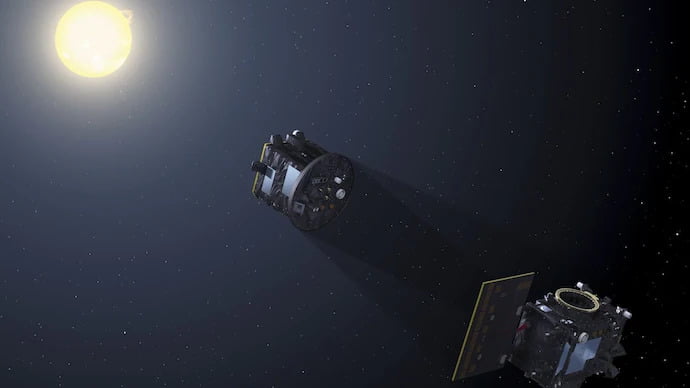| Summary |
|
The European Space Agency (ESA) and the Indian Space Research Organization (ISRO) launched the Proba-3 mission on December 5, 2024, from India aboard the PSLV-XL rocket. The mission is the first in history to create artificial solar eclipses in space using two spacecraft flying in precise formation.
Designed to study the Sun’s corona in detail, the mission could also advance space-based astronomy and improve predictions of space weather that affect satellites, power systems, and communications.
Proba-3 uses two spacecraft positioned 144 meters apart. One carries a telescope aimed at the Sun, while the other holds an occulting disc to block its bright surface, revealing the much fainter corona. This formation flying approach could lead to future missions capable of building virtual telescopes hundreds of meters wide for sharper, more detailed views of distant space objects.
The mission’s goal is the Sun’s outer atmosphere, or corona, which reaches temperatures above one million degrees Celsius despite being farther from the surface than the cooler layers below.
The corona is the source of space weather events that can damage satellites and disrupt power and communication networks. Because the corona is so faint as compared to the actual surface of the Sun, it can normally be studied only during short natural eclipses. Proba-3 will allow uninterrupted observations for up to six hours, offering data that could improve space weather forecasting.
Technical details
The Proba-3 project began in 2005 as a collaboration between ESA and ISRO. Its two spacecraft fly in a fixed line, separated by 144 meters, with the occulting disc on one craft aligned to block the Sun’s bright inner region from the telescope on the other. This arrangement makes the corona visible in much greater detail than from Earth-based observations.
Mission challenges
Formation flying at this scale requires extreme precision. The spacecraft must maintain positions accurate to within millimeters and point within thousandths of a degree, all while travelling at speeds between 1 and 10 kilometers per second. Each craft carries its own guidance systems and processors, enabling them to operate and align without constant ground control.
The mission’s orbit allows the artificial eclipse to last up to six hours. During this time, the spacecraft coordinate in real time to collect and transmit data. The extended viewing period will give scientists a detailed and continuous record of the corona, helping to answer questions about its structure, heat, and role in driving solar activity.

